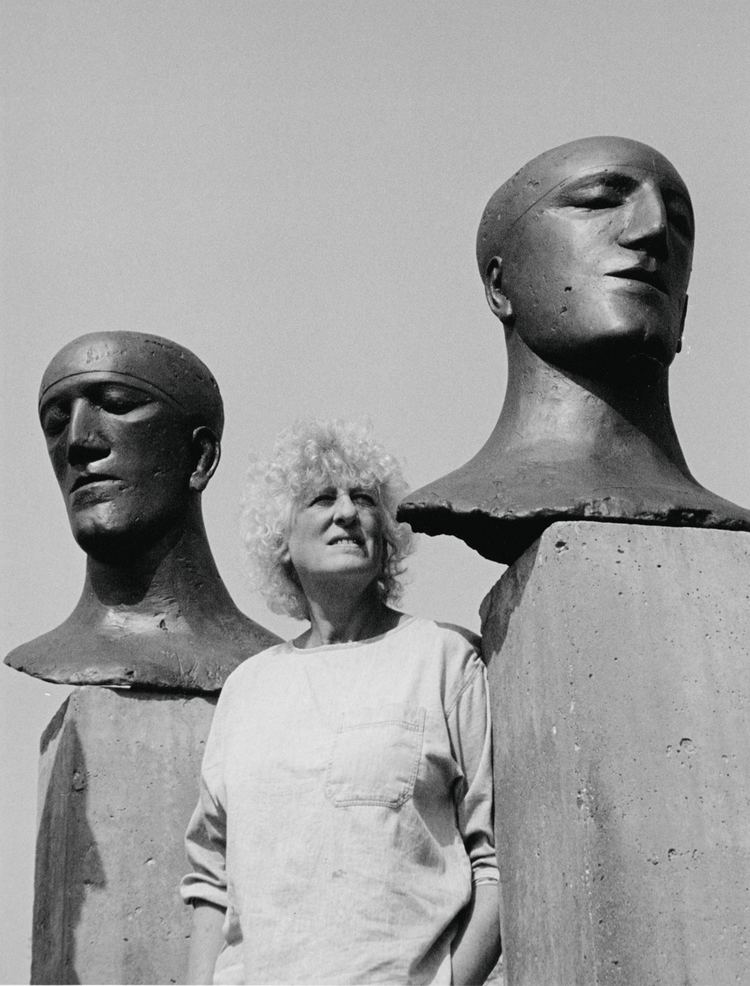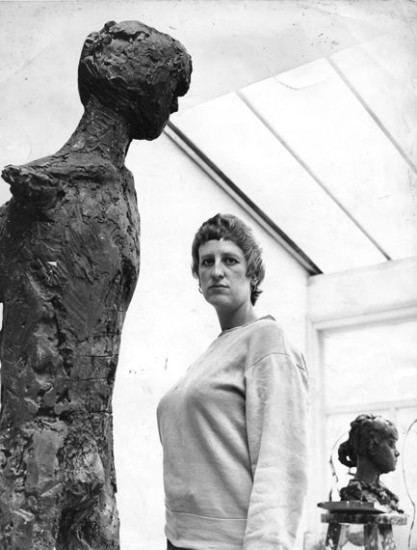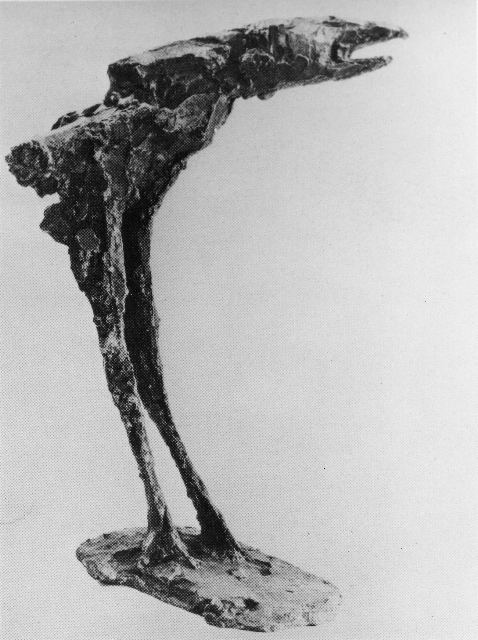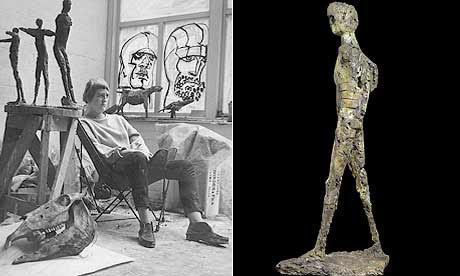Name Elisabeth Frink | ||
 | ||
Books The art of Elisabeth Frink, Elisabeth Frink: A Celebration | ||
Education Chelsea College of Arts | ||
Norman st john stevas interviews elisabeth frink 1981
Dame Elisabeth Jean Frink CH DBE RA (14 November 1930 – 18 April 1993) was an English sculptor and printmaker. Her Times obituary noted the three essential themes in her work as the nature of Man; the "horseness" of horses; and the divine in human form.
Contents
- Norman st john stevas interviews elisabeth frink 1981
- Elisabeth frink the life and works
- Career
- Personal
- Highlights
- Frink School of Figurative Sculpture
- References

Elisabeth frink the life and works
Career

Elisabeth Frink was born in Thurlow, Suffolk. Her father was a career soldier and one of those evacuated from Dunkirk in the early summer of 1940. There are suggestions that war, which broke out shortly before her ninth birthday, provided an important context for her life and career. Growing up near a military airfield in Suffolk, she would have heard bombers returning from their internecine missions, and one one occasion was forced to hide under a hedge to avoid the machine gun attack of a German fighter plane. Her early drawings, from the period before she attended arts school in London, have a powerful apocalyptic flavour: themes include wounded birds and falling men.

She studied at the Guildford School of Art (now the University for the Creative Arts) (1946–1949), under Willi Soukop, and at the Chelsea School of Art (1949–1953). She was part of a postwar group of British sculptors, dubbed the Geometry of Fear school, that included Reg Butler, Bernard Meadows, Kenneth Armitage and Eduardo Paolozzi. Frink’s subject matter included men, birds, dogs, horses and religious motifs, but very seldom any female forms. Bird (1952; London, Tate), one of a number of bird sculptures, and her first successful pieces (also Three Heads and the Figurative Tradition) with its alert, menacing stance, characterizes her early work.

Although she made many drawings and prints, she is best known for her bronze outdoor sculpture, which has a distinctive cut and worked surface. This is created by her adding plaster to an armature, which she then worked back into with a chisel and surform. This process contradicts the very essence of "modeling form" established in the modeling tradition and defined by Rodin's handling of clay.

In the 1960s Frink’s continuing fascination with the human form was evident in a series of falling figures and winged men. While living in France from 1967 to 1970, she began a series of threatening, monumental male heads, known as the goggled heads. On returning to England, she focused on the male nude, barrel-chested, with mask-like features, attenuated limbs and a pitted surface, for example Running Man (1976; Pittsburgh, PA, Carnegie Mus. A.). Frink’s sculpture, and her lithographs and etchings created as book illustrations, drew on archetypes expressing masculine strength, struggle and aggression.
The 1980s held capstones for Frink's career. In 1982, a new publishing firm proposed to produce a catalogue raisonné of all of her works to date; and the Royal Academy planned a retrospective of her life's work. The date of the retrospective, originally to be held in 1986, was moved forward a year due to space demands at the gallery, causing Frink some headaches due to her busy commissioned work schedule. In 1985 alone, she was committed to two major projects: a set of three figures for a corporate headquarters, one of which was a nearly 7-foot-tall (2.1 m) male nude; and the other, a grouping entitled Dorset Martyrs to be placed in Dorchester, Dorset.
However, despite the potential for conflict, the retrospective was a success and spurred the art world to hold more exhibitions of Frink's worth, with four solo exhibitions and several group ones coming in the following year. Tirelessly, Frink continued to accept commissions and sculpt, as well as serve on advisory committees, meet with art students who had expressed an interest in her work, and pursue other public commitments.
Frink kept up this hectic pace of sculpting and exhibiting until early 1991, when an operation for cancer of the oesophagus caused an enforced break. However, short weeks later Frink was again creating sculptures and preparing for solo exhibitions. In September, she underwent a second surgery. Again, Frink did not let this hold her back, proceeding with a planned trip for exhibitions to New Orleans, Louisiana, and New York City. The exhibitions were a success, but Frink's health was clearly deteriorating. Despite this, she was working on a colossal statue, Risen Christ, for Liverpool Cathedral. This sculpture would prove to be her last; just one week after its installation, Frink died from cancer on 18 April 1993, aged 62, in Blandford Forum, Dorset. Stephen Gardiner, Frink's official biographer, argued that this final sculpture was appropriate: "This awesome work, beautiful, clear and commanding, a vivid mirror-image of the artist's mind and spirit, created against fearful odds, was a perfect memorial for a remarkable great individual."
Personal
Frink married Michel Jammet in 1955: their son was born in 1958 and the marriage was dissolved in 1963. Between 1964 and 1974 she was married to Edward Pool. Hungarian born Alexander Csaky, whom she married as her third husband in 1974, predeceased her by only a few months.
Highlights
Warhorse and Walking Madonna may be seen in the garden at Chatsworth House. Other work is at the Jerwood Sculpture Park at Ragley Hall. Uniquely in England, Desert Quartet (1990), Frink's penultimate sculpture, was given Grade II* listing in 2007, less than 30 years from its creation by the Department for Culture, Media and Sport. It may be seen opposite Liverpool Gardens in Worthing.
Frink School of Figurative Sculpture
Before Frink died in 1993, she had given master classes at the Sir Henry Doulton School of Sculpture then headed by sculptor Colin Melborne ARA in Stoke-on-Trent, England. Rosemary Barnett took over as principal of the Sir Henry Doulton School of Sculpture, Stoke-on-Trent, briefly before its closure. In 1990 she met Harry Everington there and their shared artistic outlook brought about the Frink School of Figurative Sculpture which opened in 1996 in Longton and closed in 2005 at Tunstall.
Permission from the Frink Estate was given to name a new school after her, because it was to continue the tradition which she represented. The Frink School of Figurative Sculpture opened in 1996, with an emphasis on sculptural form; it attempted to give some balance to the declining figurative training and increased conceptualism in sculpture schools in the UK.
